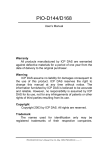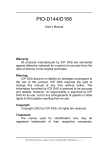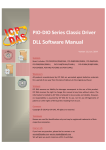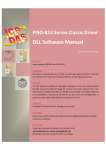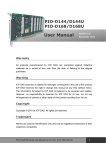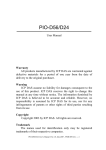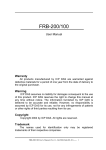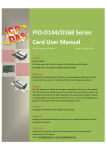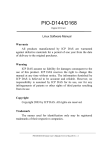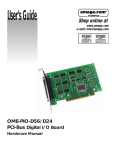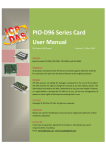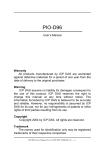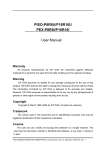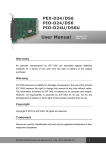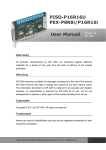Download Manual
Transcript
PIO-D56/D24 User’s Manual Warranty All products manufactured by ICP DAS are warranted against defective materials for a period of one year from the date of delivery to the original purchaser. Warning ICP DAS assumes no liability for damages consequent to the use of this product. ICP DAS reserves the right to change this manual at any time without notice. The information furnished by ICP DAS is believed to be accurate and reliable. However, no responsibility is assumed by ICP DAS for its use, nor for any infringements of patents or other rights of third parties resulting from its use. Copyright Copyright 2004 by ICP DAS. All rights are reserved. Trademark The names used for identification only may be registered trademarks of their respective companies. PIO-D56/PIO-D24 User’s Manual (Ver.2.3, JUN/2004, PPH-005-23) ---- 1 Tables of Content 1. INTRODUCTION............................................................................................4 1.1 FEATURES................................................................................................................. 4 1.2 SPECIFICATIONS ....................................................................................................... 5 1.3 PRODUCT CHECK LIST ............................................................................................. 5 2. HARDWARE CONFIGURATION ...............................................................6 2.1 BOARD LAYOUT ....................................................................................................... 6 2.2 I/O PORT LOCATION................................................................................................. 7 2.3 PIN ASSIGNMENT...................................................................................................... 8 2.4 ENABLE I/O OPERATION ........................................................................................ 10 2.4.1 DI/O Port Architecture (CON3).................................................................... 10 2.4.2 DI Port Architecture (CON2)........................................................................ 12 2.4.3 DO Port Architecture (CON1) ...................................................................... 13 2.5 INTERRUPT OPERATION.......................................................................................... 14 2.6 DAUGHTER BOARDS............................................................................................... 15 2.6.1. DB-37 ............................................................................................................ 15 2.6.2. DN-37 & DN-50 ............................................................................................ 15 2.6.3. DB-8125 ........................................................................................................ 16 2.6.4. ADP-20/PCI .................................................................................................. 16 2.6.5. DB-24P, DB-24PD Isolated Input Board...................................................... 17 2.6.6. DB-24R, DB-24RD Relay Board................................................................... 18 2.6.7. DB-24PR, DB-24POR, DB-24C.................................................................... 19 2.6.8. Daughter Board Comparison Table.............................................................. 20 3. I/O CONTROL REGISTER.........................................................................21 3.1 HOW TO FIND THE I/O ADDRESS............................................................................ 21 3.2 THE ASSIGNMENT OF I/O ADDRESS ....................................................................... 24 3.3 THE I/O ADDRESS MAP .......................................................................................... 26 3.3.1. RESET\ Control Register............................................................................... 27 3.3.2. AUX Control Register ................................................................................... 27 3.3.3. AUX data Register......................................................................................... 27 3.3.4. INT Mask Control Register ........................................................................... 28 3.3.5. Aux Status Register........................................................................................ 28 3.3.6. Interrupt Polarity Control Register............................................................... 28 3.3.7. I/O Selection Control Register ...................................................................... 29 3.3.8. Read/Write 8-bit data Register...................................................................... 30 PIO-D56/PIO-D24 User’s Manual (Ver.2.3, JUN/2004, PPH-005-23) ---- 2 4. SOFTWARE INSTALLATION ...................................................................31 4.1 SOFTWARE INSTALLING PROCEDURE..................................................................... 31 4.2 PNP DRIVER INSTALLATION .................................................................................. 31 5. DLL FUNCTION DESCRIPTION ..............................................................32 5.1 TABLE OF ERRORCODE AND ERRORSTRING .......................................................... 33 5.2 FUNCTION DESCRIPTIONS ...................................................................................... 33 5.3 FUNCTIONS OF TEST......................................................................................... 35 5.3.1 PIODIO_GetDllVersion................................................................................ 35 5.3.2 PIODIO_ShortSub ........................................................................................ 35 5.3.3 PIODIO_FloatSub ........................................................................................ 35 5.4 DIGITAL I/O FUNCTIONS .................................................................................... 36 5.4.1. PIODIO_OutputByte ..................................................................................... 36 5.4.2. PIODIO_InputByte........................................................................................ 36 5.4.3. PIODIO_OutputWord ................................................................................... 37 5.4.4. PIODIO_InputWord...................................................................................... 37 5.5 DRIVER RELATIVE FUNCTIONS .............................................................................. 38 5.5.1. PIODIO_GetDriverVersion .......................................................................... 38 5.5.2. PIODIO_DriverInit ....................................................................................... 38 5.5.3. PIODIO_SearchCard.................................................................................... 39 5.5.4. PIODIO_DriverClose ................................................................................... 39 5.5.5. PIODIO_GetConfigAddressSpace ................................................................ 40 5.6 INTERRUPT FUNCTION..................................................................................... 41 5.6.1 PIODIO_IntResetCount ................................................................................ 41 5.6.2 PIODIO_IntGetCount ................................................................................... 41 5.6.3 PIODIO_IntInstall ........................................................................................ 42 5.6.4 PIODIO_IntRemove ...................................................................................... 43 5.6.5 Architecture of Interrupt mode...................................................................... 43 5.6.6 Program Architecture.................................................................................... 44 6. DEMO PROGRAMS FOR WINDOWS......................................................45 6.1 DIGITAL INTPUT AND OUTPUT ................................................................................ 46 6.2 INTERRUPT OF P2C0............................................................................................... 46 APPENDIX.................................................................................................................47 APPENDIX A. RELATED DOS SOFTWARE ......................................................................... 47 A-1 Where is the related software ............................................................................ 47 A-2 DOS LIB Function ............................................................................................. 48 PIO-D56/PIO-D24 User’s Manual (Ver.2.3, JUN/2004, PPH-005-23) ---- 3 1. Introduction The PIO-D56/PIO-D24 provides 56/24 TTL digital I/O lines. The PIOD56 consists of one 24-bit bi-directional port, one 16-bit input port and one 16bit output port. However, PIO-D24 only contains the 24-bit bi-directional port. The 24-bit port supports three 8-bit groups, which are PA, PB and PC, respectively. Each 8-bit group can be individually configured to function as digital input or output port. Each group in a 24-bit bi-directional port is configured as digital inputs once the power is turned on or if a reset has been executed. DB-24PD is the daughter board, which is designed to connect the input port for either isolation purposes or to interface to the output port for relay control. PIO-D24 has one D-sub connector. However, The PIO-D56 contains one D-sub connector and two 20-pin flat cables. The flat cable can be connected to an ADP-20/PCI adapter. The adapter can be fixed onto the chassis. This product can be installed into a 5V PCI bus and supports actual “Plug & Play” technology. 1.1 • • • • • • • Features • • PCI bus Up to 56/24(PIO-D56/PIO-D24) digital I/O channels lines All I/O lines buffered on the board 3 Eight-bit groups independently selectable for I/O on 24-bit port Input / Output ports can be configured via software control Double side SMD, short card. Connects directly to DB-24PR, DB-24PD, DB-24RD, DB-24PRD, DB-16P8R, DB-24POR, DB-24SSR, DB-24C or any OPTO-22 compatible daughter board 4 interrupt sources: P2C0, P2C1, P2C2, P2C3 One DB37 connector, two 20-pin flat cable connectors (only for PIO-D56) • • • High driving capability Automatically detected by Windows 95/98/2000/XP No base address or IRQ switches to set PIO-D56/PIO-D24 User’s Manual (Ver.2.3, JUN/2004, PPH-005-23) ---- 4 1.2 Specifications • All inputs are TTL compatible Logic high voltage : 2.4V (Min.) Logic low voltage : 0.8V (Max.) • All outputs are TTL compatible OPTO-22 output (CON3): Sink current : 64mA (Max.) Source current : 32mA(Max.) • • • 16-channel output (CON1): Sink current : 8mA (Max.) Source current : 0.4mA(Max.) Environmental : Operating Temperature: 0°C to 60°C Storage Temperature: -20°C to 80°C Humidity: 0 to 90% non-condensing Dimensions: 143mm X 105mm Power Consumption: +5V @ 530mA/420mA(PIO-D56/PIO-D24) 1.3 Product Check List In addition to this manual, the package includes the following items: • One PIO-D56(or PIO-D24) card • One company floppy diskette or CD • One release note It is recommended to read the release note first. All important information will be given in the release in the following order: 1. Where you can find the software driver & utility. 2. How to install the software & utility 3. Where the diagnostic program is. 4. FAQ’s. Attention: If any of these items is missing or damaged, contact the dealer from whom you purchased the product. Save the shipping materials and carton in case you want to ship or store the product in the future. PIO-D56/PIO-D24 User’s Manual (Ver.2.3, JUN/2004, PPH-005-23) ---- 5 2. Hardware configuration 2.1 Board Layout Figure2.1 PIO-D56/PIO-D24 User’s Manual (Ver.2.3, JUN/2004, PPH-005-23) ---- 6 2.2 I/O Port Location The PIO-D56/PIO-D24 consists of one 24-bit bi-directional port, one 16-bit input port and one 16-bit output port (only for PIO-D56). The 24-bit port supports three 8-bit groups, which are PA, PB and PC, respectively. Each 8bit group can be configured as a D/I or D/O port via the software. Note that when the PC is first turned on or if a reset has been executed, all ports are set as D/I ports. The I/O port location is given as follows: Table 2.1 Connector of PIO-D56/D24 PA0 ~ PA7 PB0 ~ PB7 P2C0 ~ PC7 CON3 (DI/O) Port0 Port1 Port2 Table 2.2 Connector of PIO-D56 Description CON1 D/O CON2 D/I Refer to Sec. 2.1 for board layout & I/O port location. Note : P2C0, P2C1, P2C2 and P2C3 can be used as interrupt signal source. Refer to Sec. 2.5 for more information. PIO-D56/PIO-D24 User’s Manual (Ver.2.3, JUN/2004, PPH-005-23) ---- 7 2.3 Pin Assignment The Pin assignments for all connectors on the PIO-D56/D24 are represented in Tables 2.3, 2.4 and 2.5. All signal sources for each digital input or output pin (channel) is TTL compatible. Table 2.3 CON3: 37 pin D-type female connector(for Port0, Port1, Port2). Pin Number Description Pin Number Description 1 N.C. 20 VCC 2 N.C. 21 GND 3 P1B7 22 P2C7 4 P1B6 23 P2C6 5 P1B5 24 P2C5 6 P1B4 25 P2C4 7 P1B3 26 P2C3 8 P1B2 27 P2C2 9 P1B1 28 P2C1 10 P1B0 29 P2C0 11 GND 30 P0A7 12 N.C. 31 P0A6 13 GND 32 P0A5 14 N.C. 33 P0A4 15 GND 34 P0A3 16 N.C. 35 P0A2 17 GND 36 P0A1 18 VCC 37 P0A0 19 GND XXXXXXX This pin not available PIO-D56/PIO-D24 User’s Manual (Ver.2.3, JUN/2004, PPH-005-23) ---- 8 Table 2.4 CON1 : 20-pin header (only for PIO-D56) Pin Number Description Pin Number Description 1 DO0 2 DO1 3 DO2 4 DO3 5 DO4 6 DO5 7 DO6 8 DO7 9 DO8 10 DO9 11 DO10 12 DO11 13 DO12 14 DO13 15 DO14 16 DO15 17 GND 18 GND 19 Vcc 20 +12V Table 2.5 CON2 : 20-pin header (only for PIO-D56) Pin Number Description Pin Number Description 1 DI0 2 DI1 3 DI2 4 DI3 5 DI4 6 DI5 7 DI6 8 DI7 9 DI8 10 DI9 11 DI10 12 DI11 13 DI12 14 DI13 15 DI14 16 DI15 17 GND 18 GND 19 Vcc 20 +12V PIO-D56/PIO-D24 User’s Manual (Ver.2.3, JUN/2004, PPH-005-23) ---- 9 2.4 Enable I/O Operation When the PC is turned on, all operations involved with digital I/O channels(CON1, CON2, CON3) are disabled. Note that the digital I/O channels are enabled or disabled by the RESET\ signal. (Refer to Sec. 3.3.1 for more information related to this). 2.4.1 DI/O Port Architecture (CON3) The power-on states for all DI/O ports(CON3) are given as follows: • D/I/O operations for each port are disabled. • D/I/O ports are all configured as Digital input ports. • D/O latch register outputs are all undefined. The user has to perform some initialization before using these digital I/O ports. The recommended steps are given as follows: Step 1: Find the address-mapping for PIO/PISO cards. (Refer to Sec.3.1) Step 2: Enable all Digital I/O operations. (Refer to Sec. 3.3.1). Step 3:Configure the three ports (in CON3) to their expected D/I/O states & send their initial values to every D/O port (Refer to Sec. 3.3.7 and Sec.3.3.8) For more information on the initial procedure for digital I/O ports, please refer to the DEMO1.C demo program. PIO-D56/PIO-D24 User’s Manual (Ver.2.3, JUN/2004, PPH-005-23) ---- 10 The digital I/O (CON3) control architecture for the PIO-D56/D24 is demonstrated in Figure 2.2. The operation method used for the control signal is presented below. • • • • • RESET\ is in the Low-state all D/I/O operations are disabled RESET\ is in the High-state all D/I/O operations are enabled. If D/I/O is configured as a D/I port D/I= external input signal If D/I/O is configured as a D/O port D/I = read back of D/O If D/I/O is configured as a D/I port sending data to a Digital input port will only change the D/O latch register. The latched data will be output when the port is configured as digital output and is activated right away. Figure2.2 DI/O Port Architecture(CON3) PIO-D56/PIO-D24 User’s Manual (Ver.2.3, JUN/2004, PPH-005-23) ---- 11 2.4.2 DI Port Architecture (CON2) The digital input (CON2) control architecture for the PIO-D56 is demonstrated in Figure 2.3. • • RESET\ is in the Low-state RESET\ is in the High-state all DI operations are disabled all DI operations are enabled Figure2.3 DI Port Architecture (CON2) PIO-D56/PIO-D24 User’s Manual (Ver.2.3, JUN/2004, PPH-005-23) ---- 12 2.4.3 DO Port Architecture (CON1) The digital output (CON1) control architecture for the PIO-D56 is demonstrated in Figure 2.4. • • RESET\ is in the Low-state RESET\ is in the High-state • • The power-on states are as follows: All DO operations are disabled All output latches are cleared to Low-Level all DO operations are disabled all DO operations are enabled Figure2.4 DO Port Architecture (CON1) PIO-D56/PIO-D24 User’s Manual (Ver.2.3, JUN/2004, PPH-005-23) ---- 13 2.5 Interrupt Operation The P2C0, P2C1, P2C2 and P2C3 can be used as interrupt signal source. Refer to Sec. 2.1 for P2C0/P2C1/P2C2/P2C3 location. The interrupt of the PIO-D56/PIO-D24 is level-trigger & Active_High. The interrupt signal can be programmable as inverted or non-inverted. The procedures for how to configure the interrupt signal source are given as follows: 1. Make sure the initial level is high or Low from the signal source. 2. If the initial state is High, please select the inverted setting for interrupt signal source (Section. 3.3.6). If the initial state is Low, please select the non-inverted setting for interrupt signal source (Section. 3.3.6) 3. Enable the interrupt function (Section. 3.3.4) 4. If the interrupt signal is active, the interrupt service routine will be started up. Note that DEMO3.C & DEMO4.C are demo programs for a single interrupt source and DEMO5.C is the demo program for four interrupt sources in the DOS operating system. If only one interrupt signal source is used, the interrupt service routine does not need to identify the interrupt source. (Refer to DEMO3.C & DEMO4.C). However, if there are more than one interrupt source, the interrupt service routine has to identify the active signals in the following manner: (refer to DEMO5.C) 1. Read the new status of the interrupt signal sources 2. Compare the new status with the old status to identify the active signals 3. If P2C0 is active, service P2C0 & non-inverter/inverted the P2C0 signal 4. If P2C1 is active, service P2C1 & non-inverted/inverted the P2C1 signal 5. If P2C2 is active, service P2C2 & non-inverted/inverted the P2C2 signal 6. If P2C3 is active, service P2C3 & non-inverted/inverted the P2C3 signal 7. Update the interrupt status. Limitation: if the interrupt signal is too short, the new status may be the same as the old status. So the interrupt signal must be held active until the interrupt service routine has been executed. This hold time is different for differing operating systems. The hold time can be as short as a micro-second or as long as 1 second. In general, 20ms is enough for all O.S. PIO-D56/PIO-D24 User’s Manual (Ver.2.3, JUN/2004, PPH-005-23) ---- 14 2.6 Daughter Boards 2.6.1. DB-37 The DB-37 is a general purpose daughter board for D-sub 37 pins. It is designed for easy wire connection via pin-to-pin. Figure 2.5 DB-37 2.6.2. DN-37 & DN-50 The DN-37 is a general purpose daughter board for DB-37 pins with DINRail Mountings. The DN-50 is designed for 50-pin flat-cable headers win DINRail mountings. They are also designed for easy wire connection via pin-to-pin. Figure 2.6 DN-37/DN-50 PIO-D56/PIO-D24 User’s Manual (Ver.2.3, JUN/2004, PPH-005-23) ---- 15 2.6.3. DB-8125 The DB-8125 is a general purpose screw terminal board. It is designed for easy wire connection. The DB-8125 consists of one DB-37 & two 20-pin flatcable headers. Figure 2.7 DB-1825 2.6.4. ADP-20/PCI The ADP-20/PCI is an extender for the 20-pin header. The one side of the ADP-20/PCI can be connected to a 20-pin header. The other side can be mounted onto the PC chassis as is depicted by the following: Figure 2.8 ADP-20/PCI PIO-D56/PIO-D24 User’s Manual (Ver.2.3, JUN/2004, PPH-005-23) ---- 16 2.6.5. DB-24P, DB-24PD Isolated Input Board The DB-24P is a 24-channel isolated digital input daughter board. The optically isolated inputs of the DB-24P consist of a bi-directional optocoupler with a resistor for current sensing. You can use the DB-24P to sense DC signals from TTL levels up to 24V or use the DB-24P to sense a wide range of AC signals. You can also use this board to isolate the computer from large common-mode voltage, ground loops and transient voltage spikes that often occur in industrial environments, as shown in Figure 2.9. Table 2.4 is the comparison of DB-24P and DB-24PD. Figure 2.9 Table 2.6 DB-24P DB-24PD 50-pin flat-cable header Yes Yes D-sub 37-pin header No Yes Other specifications Same PIO-D56/PIO-D24 User’s Manual (Ver.2.3, JUN/2004, PPH-005-23) ---- 17 2.6.6. DB-24R, DB-24RD Relay Board The DB-24R, 24-channel relay output board, consists of 24 form-C relays for efficiently controlling the switch with the use of an appropriately loaded program. The relays are energized by applying a 12V/24V voltage signal to the appropriate relay channel on the 50-pin flat-cable connector. There are 24 enunciator LEDs for each relay channel and the LED light will go on when their associated relay has been activated. The control scheme is illustrated below. Figure 2.10 Table 2.7 DB-24R DB-24RD 50-pin flat-cable header Yes Yes D-sub 37-pin header No Yes Other specifications Same Table 2.8 DB-24R, DB-24RD 24*Relay (120V, 0.5A) DB-24PR,DB-24PRD 24* Power Relay (250V, 5A) DB-24POR 24*PhotoMOS Relay (350V, 01.A) DB-24SSR 24*SSR (250VAC, 4A) DB-24C 24*O.C. (30V, 100 mA) DB-16P8R 16*Relay (120V, 0.5A) + 8*isolated input PIO-D56/PIO-D24 User’s Manual (Ver.2.3, JUN/2004, PPH-005-23) ---- 18 2.6.7. DB-24PR, DB-24POR, DB-24C Table 2.9 DB-24PR 24*power relay, 5A/250V DB-24POR 24*PhotoMOS relay, 0.1A/350VAC DB-24C 24*open collector, 100mA per channel, 30V max. The DB-24PR, 24-channel power relay output board, consists of 8 formC and 16 form-A electromechanical relays for efficiently controlling the switch with the use of an appropriately loaded program. The contact of each relay can allow 5A current load at 250ACV/30VDCV. The relay is energized by applying a 5 voltage signal to the associate relay channel on the 20-pin flatcable connector (just used 16 relays) or 50-pin flat-cable connector (OPTO-22 compatible, for DIO-24 series). 24 enunciator LEDs for indicating the status of for each relay and the corresponding LED light will go on when their associated relay has been activated. To avoid overloading your PC’s power supply, this board needs a +12VDC or +24VDC external power supply, as shown in figure 2.11. Figure 2.11 Note: 1. 50-Pin connector(OPTO-22 compatible), for DIO-24, DIO-48, DIO-144, PIO-D144, PIO-D96, PIO-D56, PIO-D48, PIO-D24,PIO-D168 2. 20-Pin connector for 16 channel digital output, A-82X, A-62X, DIO-64, ISO-DA16/DA8, 3. Channel: 16 Form A Relay , 8 Form C Relay. 4. Relay: switching up to 5A at 110ACV / 5A at 30DCV. PIO-D56/PIO-D24 User’s Manual (Ver.2.3, JUN/2004, PPH-005-23) ---- 19 2.6.8. Daughter Board Comparison Table Table 2.10 20-pin flat-cable 50-pin flat-cable D-sub 37-pin DB-37 No No Yes DN-37 No No Yes ADP-37/PCI No Yes Yes ADP-50/PCI No Yes No DB-24P No Yes No DB-24PD No Yes Yes DB-16P8R No Yes Yes DB-24R No Yes No DB-24RD No Yes Yes DB-24C Yes Yes Yes DB-24PR Yes Yes No Db-24PRD No Yes Yes DB-24POR Yes Yes Yes DB-24SSR No Yes Yes Note : There is no 50-pin flat cable header in the PIO-D56/PIO-D24. The PIOD56/PIO-D24 has one DB-37 connector and two 20 pin flat-cable headers (only for PIO-D56). PIO-D56/PIO-D24 User’s Manual (Ver.2.3, JUN/2004, PPH-005-23) ---- 20 3. I/O Control Register 3.1 How to Find the I/O Address The plug & play BIOS will assign a proper I/O address to every PIO/PISO series card in the power-on stage. The IDs for the PIO-D56/D24 cards are given as follows: PIO-D24 : < REV 1.0 ~ REV 5.0 > : • Vendor ID = 0xE159 • Device ID = 0x0002 • • • Sub-vendor ID = 0x80 Sub-device ID = 0x01 Sub-aux ID = 0x40 < REV 6.0 or above > : • Vendor ID = 0xE159 • Device ID = 0x0001 • • • Sub-vendor ID = 0xC080 Sub-device ID = 0x01 Sub-aux ID = 0x40 PIO-D56 : < REV 1.0 ~ REV 4.0 > : • Vendor ID = 0xE159 • Device ID = 0x0002 • • • Sub-vendor ID = 0x80 Sub-device ID = 0x01 Sub-aux ID = 0x40 < REV 5.0 or above > : • Vendor ID = 0xE159 • Device ID = 0x0001 • • • Sub-vendor ID = 0xC080 Sub-device ID = 0x01 Sub-aux ID = 0x40 PIO-D56/PIO-D24 User’s Manual (Ver.2.3, JUN/2004, PPH-005-23) ---- 21 The utility program, PIO_PISO.EXE, will detect and present all information from the PIO/PISO cards installed on this PC, as shown in the following figure. The necessary means for identifying the PIO series cards of ICPDAS data acquisition boards by the sub-vender, sub-device and sub-Aux ID is given in table 3-1 below the following figure. Figure 3.1 PIO-D56/PIO-D24 User’s Manual (Ver.2.3, JUN/2004, PPH-005-23) ---- 22 Table 3-1 PIO/PISO series card PIO-D168 PIO-D168A PIO-D144(REV4.0) PIO-D96 (REV4.0) PIO-D64 (REV2.0) PIO-D56 (REV5.0) PIO-D48 (REV2.0) PIO-D24 (REV6.0) PIO-821 PIO-DA16 PIO-DA8 PIO-DA4 PISO-C64 PISO-A64 PISO-P64 PISO-P32C32 PISO-P32A32 PISO-P8R8 PISO-P8SSR8AC PISO-P8SSR8DC PISO-730 PISO-730A PISO-813 PISO-DA2 Description 168 * DIO 168 * DIO 144 * D/I/O 96 * D/I/O 64 * D/I/O 24 * D/I/O + 16 * D/I+16*D/O 48 * D/I/O 24 * D/I/O Multi-function 16 * D/A 8 * D/A 4 * D/A 64 * isolated D/O (Current sinking) 64 * isolated D/O (Current sourcing) 64 * isolated D/I 32* isolated D/O (Current sinking) + 32* isolated D/I 32*isolated DO (Current sourcing) + 32* isolated D/I 8* isolated D/I + 8 * 220V relay 8* isolated D/I + 8 * SSR /AC 8* isolated D/I + 8 * SSR /DC 16*DI + 16*D/O + 16* isolated D/I + 16*isolated D/O (Current sinking) 16*DI + 16*D/O + 16* isolated D/I + 16*isolated D/O (Current sourcing) 32 * isolated A/D 2 * isolated D/A Sub_Sendor Sub_Device Sub_AUX 9880 80 80 (5C80) 80 (5880) 80 (4080) 80 (C080) 01 01 01 01 01 01 50 50 00 10 20 40 80 (0080) 80 (C080) 80 80 80 80 80 01 01 03 04 04 04 08 30 40 10 00 00 00 00 80 08 50 80 80 08 08 10 20 80 08 70 80 08 30 80 08 30 80 08 30 80 08 40 80 08 80 80 80 0A 0B 00 00 Note: If your board is a different version, it may also have different Sub IDs. However this will present no actual problem. No matter which version of the board you select, we offer the same function calls. PIO-D56/PIO-D24 User’s Manual (Ver.2.3, JUN/2004, PPH-005-23) ---- 23 3.2 The Assignment of the I/O Address The Plug & Play BIOS will assign the proper I/O address to a PIO/PISO series card. If there is only one PIO/PISO board, the user can identify the board as card_0. If there are two PIO/PISO boards in the system, the user will find it very difficult to identify which board is card_0. The software driver can support a maximum of 16 boards. Therefore, the user can install 16 PIO/PSIO series cards onto one PC system. The methods used to find and identify card_0 and card_1 is demonstrated below: The simplest way to identify which card is card_0 is to use wSlotBus & wSlotDevice in the following manner: 1. Remove all PIO-D56/D24 boards from the PC. 2. Install one PIO- D56/D24 into the PC’s PCI_slot1, run PIO_PISO.EXE. Then record the wSlotBus1 and wSlotDevice1 information. 3. Remove all PIO- D56/D24 boards from the PC. 4. Install one PIO- D56/D24 into the PC’s PCI_slot2 and run PIO_PISO.EXE. Then record the wSlotBus2 and wSlotDevice2 information. 5. Repeat steps (3) & (4) for every PCI_slot and record all the information from wSlotBus and wSlotDevice. 6. The records may look similar to the table follows: Table 3-2 PC’s PCI slot WslotBus WslotDevice Slot_1 0 0x07 Slot_2 0 0x08 Slot_3 0 0x09 Slot_4 0 0x0A Slot_5 1 0x0A Slot_6 1 0x08 Slot_7 1 0x09 Slot_8 1 0x07 PCI-BRIDGE The above procedure will record all the wSlotBus and wSlotDevice information on a PC. These values will be mapped to this PC’s physical slot. This mapping will not be changed for any PIO/PISO card. Therefore, this PIO-D56/PIO-D24 User’s Manual (Ver.2.3, JUN/2004, PPH-005-23) ---- 24 information can be used to identify the specified PIO/PISO card by following these next 3 steps: Step1: Using the wSlotBus and wSlotDevice information in table 3-2 Step2: Input the board number into funtion PIO_GetConfigAddressSpace(…) to get the specified card’s information, especially the wSlotBus and wSlotDevice information. Step3: The user can identify a specified PIO/PISO card by comparing it to the data from the wSlotBus & wSlotDevice found in step1 and step2. Note that normally the card installed in slot 0 is card0 and the card installed in slot1 is card1 for PIO/PISO series cards. PIO-D56/PIO-D24 User’s Manual (Ver.2.3, JUN/2004, PPH-005-23) ---- 25 3.3 The I/O Address Map The I/O address for PIO/PISO series cards are automatically assigned by the main board ROM BIOS. The I/O address can also be re-assigned by the user. It is strongly recommended that users do not change the I/O address. The Plug & Play BIOS will effectively perform the assignment of proper I/O addresses to each PIO/PISO series card. The I/O addresses for the PIO-D56/D24 are given in the table below, all of which are based on the base address of each card. Table 3-3 Address Read Write Wbase+0 RESET\ control register Same Wbase+2 Aux control register Same Wbase+3 Aux data register Same Wbase+5 INT mask control register Same Wbase+7 Aux pin status register Same Wbase+0x2a INT polarity control register Same Wbase+0xc0 read Port0 write Port0 Wbase+0xc4 read Port1 write Port1 Wbase+0xc8 read Port2 write Port2 Wbase+0xcc read configuration Port0~Port2 configuration Wbase+0xd0 read CON2 Low byte (only for PIO-D56) write CON1 Low byte (only for PIO-D56) Wbase+0xd4 read CON2 high byte (only for PIO-D56) write CON1 high byte (only for PIO-D56) PIO-D56/PIO-D24 User’s Manual (Ver.2.3, JUN/2004, PPH-005-23) ---- 26 3.3.1. RESET\ Control Register (Read/Write): wBase+0 Bit 7 Bit 6 Bit 5 Bit 4 Bit 3 Bit 2 Bit 1 Bit 0 Reserved Reserved Reserved Reserved Reserved Reserved Reserved RESET\ When the PC’s power is first turned on, RESET\ signal is in a Low-state. This will disable all D/I/O operations. The user has to set the RESET\ signal to a High-state before any D/I/O command applications are initiated. outportb (wBase,1); outportb (wBase,0); /* RESET\=High /* RESET\=Low all D/I/O are enable now */ all D/I/O are disable now */ 3.3.2. AUX Control Register (Read/Write): wBase+2 Bit 7 Bit 6 Bit 5 Bit 4 Bit 3 Bit 2 Bit 1 Bit 0 Aux7 Aux6 Aux5 Aux4 Aux3 Aux2 Aux1 Aux0 Aux?=0 Aux?=1 this Aux is used as a D/I this Aux is used as a D/O When the PC is first turned on, all Aux signals are in a Low-state. All Aux are designed as D/I for all PIO/PISO series. 3.3.3. AUX data Register (Read/Write): wBase+3 Bit 7 Bit 6 Bit 5 Bit 4 Bit 3 Bit 2 Bit 1 Bit 0 Aux7 Aux6 Aux5 Aux4 Aux3 Aux2 Aux1 Aux0 When the Aux is used for D/O, the output state is controlled by this register. This register is designed for feature extension. Therefore, do not use this register. PIO-D56/PIO-D24 User’s Manual (Ver.2.3, JUN/2004, PPH-005-23) ---- 27 3.3.4. INT Mask Control Register (Read/Write): wBase+5 Bit 7 Bit 6 Bit 5 Bit 4 Bit 3 Bit 2 Bit 1 Bit 0 0 0 0 0 EN3 EN2 EN1 EN0 EN0=0 EN0=1 Disable P2C0 as a interrupt signal (Default). Enable P2C0 as a interrupt signal outportb(wBase+5,0); /* Disable interrupt outportb(wBase+5,1); /* Enable interrupt P2C0 outportb(wBase+5,0x0f); /* Enable interrupt P2C0, P2C1,P2C2,P2C3 */ */ */ 3.3.5. Aux Status Register (Read/Write): wBase+7 Bit 7 Bit 6 Bit 5 Bit 4 Bit 3 Bit 2 Bit 1 Bit 0 Aux7 Aux6 Aux5 Aux4 Aux3 Aux2 Aux1 Aux0 Aux0=P2C0, Aux1=P2C1, Aux2=P2C2, Aux3=P2C3, Aux7~4=Aux-ID. Refer to DEMO5.C for more information. The Aux 0~3 are used as interrupt source. The interrupt service routine has to read this register to identify the interrupt source. Refer to Sec. 2.5 for more information. 3.3.6. Interrupt Polarity Control Register (Read/Write): wBase+0x2A Bit 7 Bit 6 Bit 5 Bit 4 Bit 3 Bit 2 Bit 1 Bit 0 0 0 0 0 INV3 INV2 INV1 INV0 This register provides a function to control invert or non-invert for the interrupt signal source. A detailed application example is given below. INV0=1 INV0=0 select the non-inverted signal from P2C0 select the inverted signal from P2C0 PIO-D56/PIO-D24 User’s Manual (Ver.2.3, JUN/2004, PPH-005-23) ---- 28 outportb(wBase+0x2a,0x0f); /* select the non-inverted input P2C0/1/2/3 outportb(wBase+0x2a,0x00); /* select the inverted input of P2C0/1/2/3 outportb(wBase+0x2a,0x0e); /* select the inverted input of P2C0 /* select the non-inverted input P2C1/2/3 outportb(wBase+0x2a,0x0c); /* select the inverted input of P2C0/1 /* select the non-inverted input P2C2/3 */ */ */ */ */ */ Refer to Sec. 2.5 and DEMO5.C for more information. 3.3.7. I/O Selection Control Register (Write): wBase+0xcc Bit 7 Bit 6 Bit 5 Bit 4 Bit 3 Bit 2 Bit 1 Bit 0 0 0 0 0 0 Port2 Port1 Port0 This register provide the function for configuration digital input/output port of the PIO-D56/D24. Every I/O port can be programmed to be a D/I or a D/O port. Note that all ports are used as D/I ports when the PC is first turned on. Port? = 1 Port? = 0 this port is used as a D/O port this port is used as a D/I port outportb(wBase+0xcc,0x00); /* set Port0/1/2 as D/I port */ outportb(wBase+0xcc,0x04); /* set Port0/1 as D/I port /* set Port2 as D/O port */ */ PIO-D56/PIO-D24 User’s Manual (Ver.2.3, JUN/2004, PPH-005-23) ---- 29 3.3.8. Read/Write 8-bit data Register (Read/Write):wBase+0xc0/0xc4/0xc8/0xd0/0xd4 Bit 7 Bit 6 Bit 5 Bit 4 Bit 3 Bit 2 Bit 1 Bit 0 D7 D6 D5 D4 D3 D2 D1 D0 There are five/three 8-bit I/O ports in the PIO-D56/PIO-D24. Each port is easy to read/write by access his owns data register. outportb(wBase+0xc0,Val); Val=inportb(wBase+0xc0); /* write to port-0 /* read from port-0 */ */ outportb(wBase+0xcc,0x07); outportb(wBase+0xc0,i1); outportb(wBase+0xc4,i2); outportb(wBase+0xc8,i3); /* set Port0~Port2 as DO port /* write to Port0 /* write to Port1 /* write to Port2 */ */ */ */ outportb(wBase+0xcc,0x01); outportb(wBase+0xc0,i1); j2=inportb(wBase+0xc4); j3=inportb(wBase+0xc8); /* set Port0 as DO port /* Port1~Port2 as DI port /* write to Port0 /* read Port1 /* read Port2 */ */ */ */ */ L=inportb(wBase+0xd0); H=inportb(wBase+0xd4); Val=(H<<8)+L ; /* read CON2 Low byte /* read CON2 High byte /* Val is 16 bit data outportb(wBase+0xd0,Val); /* write to CON1 Low byte outportb(wBase+0xd4,(Val>>8)); /* write to CON1 high byte */ */ */ */ */ Note: Make sure the I/O port configuration (DI or DO) before read/write the data register(wBase+0xc0/0xc4/0xc8), (refer to Sec.3.3.7 and Table 3.3 for more information). PIO-D56/PIO-D24 User’s Manual (Ver.2.3, JUN/2004, PPH-005-23) ---- 30 4. Software Installation The PIO-D56/D24 can be used in DOS and Windows 98/Me/NT/2000/XP. For Windows O.S, the recommended installation steps are given in Sec 4.1 ~ 4.2 4.1 Software Installing Procedure Step 1: Insert the companion CD into the CD-ROM driver and wait a few seconds until the installation program starts automatically. If it does not start automatically for some reason, then please double-click the file \NAPDOS\AUTO32.EXE on the CD. Step 2: Click the item: Install Toolkits (Software) / Manuals. Step 3: Click the item: PCI Bus DAQ Card. Step 4: Click PIO-DIO. Step 5: Click “install Toolkit for Windows 98 (Or Me, NT, 2000, XP)”. Then, the InstallShield will start the driver installation process to copy the related material to the indicated directory and register the driver on your computer. The driver target directory is as below for different systems. Windows NT/2000/XP : The PIODIO.DLL will be copied onto C:\WINNT\SYSTEM32 The NAPWNT.SYS and PIO.SYS will be copied into C:\WINNT\SYSTEM32\DRIVERS Windows 95/98/Me : The PIODIO.DLL,and PIODIO.Vxd will be copied onto C:\Windows\SYSTEM 4.2 PnP Driver Installation After installing the hardware (PIO-D56/D24) and you turn the power on for your PC, Windows 98/Me/2000/XP will find a PCI card device and then ask the user to provide a PIODIO.inf to install the hardware driver onto the computer. If the user has trouble preceding through this process, please refer to PnPinstall.pdf for more information. PIO-D56/PIO-D24 User’s Manual (Ver.2.3, JUN/2004, PPH-005-23) ---- 31 5. DLL Function Description The DLL driver is the collection of function calls on the PIO-DIO card for the Windows 98/Me/NT/2000/XP system. The application structure is presented in following figure. The user application program was developed by designated tools such as VB, Delphi and Borland C++ Builder which can call on the PIODIO.DLL driver in the user mode. Following that the DLL driver will call up PIO.sys to access the hardware system. Figure 5.1 PIO-D56/PIO-D24 User’s Manual (Ver.2.3, JUN/2004, PPH-005-23) ---- 32 5.1 Table of ErrorCodes and ErrorStrings Table 5.1 Error Code Error ID Error String 0 PIODIO_NoError OK ( No error !) 1 PIODIO_DriverOpenError Device driver can not be opened 2 PIODIO_DriverNoOpen Users have to call the DriverInit function first 3 PIODIO_GetDriverVersionError Get driver version error 4 PIODIO_InstallIrqError Install IRQ Error 5 PIODIO_ClearIntCountError Clear counter value Error 6 PIODIO_GetIntCountError Get counter interrput error 7 PIODIO_RemoveIrqError Remove IRQ Error 8 PIODIO_FindBoardError Can not find board 9 PIODIO_ExceedBoardNumber The Max. board is: 8 10 PIODIO_ResetError Can't reset interrupt count 11 PIODIO_IrqMaskError Irq-Mask is 1,2,4,8 or 1 to 0xF 12 PIODIO_ActiveModeError Active-Mode is 1,2 or 1 to 3 13 PIODIO_GetActiveFlagError Can’t get interrupt active flag 14 PIODIO_ActiveFlagEndOfQueue The flag queue is empty 5.2 Function Descriptions All of the functions provided for the PIO-D24/56 are listed below with more detailed information for every function presented in the following section. However, in order to make the description more simple and clear, the attributes for the input and output parameters of the function are indicated as [input] and [output] respectively, as shown in following table. Table 5.2 Keyword Setting parameter by user before calling this function ? Get the data/value from this parameter after calling this function ? [Input] Yes No [Output] No Yes [Input, Output] Yes Yes PIO-D56/PIO-D24 User’s Manual (Ver.2.3, JUN/2004, PPH-005-23) ---- 33 Table 5.3 Return Type Function Definition float short WORD WORD PIODIO_FloatSub(float fA, float fB); PIODIO_ShortSub(short nA, short nB); PIODIO_GetDllVersion(void); PIODIO_DriverInit(void); void PIODIO_DriverClose(void); WORD WORD PIODIO_SearchCard(WORD *wBoards, DWORD dwPIOCardID); PIODIO_GetDriverVersion(WORD *wDriverVersion); WORD PIODIO_GetConfigAddressSpace(WORD wBoardNo, DWORD *wAddrBase, WORD *wIrqNo, WORD *wSubVendor, WORD *wSubDevice,WORD *wSubAux, WORD *wSlotBus,WORD *wSlotDevice); WORD WORD void DWORD WORD PIODIO_ActiveBoard( WORD wBoardNo ); PIODIO_WhichBoardActive(void); PIODIO_OutputWord(DWORD wPortAddress, DWORD wOutData); PIODIO_OutputByte(DWORD wPortAddr, WORD bOutputValue); PIODIO_InputWord(DWORD wPortAddress); PIODIO_InputByte(DWORD wPortAddr); WORD PIODIO_IntInstall(WORD wBoardNo, HANDLE *hEvent, WORD wInterruptSource, WORD wActiveMode); WORD WORD WORD PIODIO_IntRemove(void); PIODIO_IntResetCount(void); PIODIO_IntGetCount(DWORD *dwIntCount); void PIO-D56/PIO-D24 User’s Manual (Ver.2.3, JUN/2004, PPH-005-23) ---- 34 5.3 FUNCTIONS OF TEST 5.3.1 • • • • 5.3.2 • • • • 5.3.3 • • • • PIODIO_GetDllVersion Description: To get the version number of PIODIO.DLL driver Syntax: WORD PIODIO_GetDllVersion(Void) Parameter: None Return: 200(hex) for version 2.00 PIODIO_ShortSub Description: To perform the subtraction as nA - nB in short data type. This function is provided for testing DLL linkage purpose. Syntax: short PIODIO_ShortSub(short nA, short nB) Parameter: nA :[Input] 2 bytes short data type value nB :[Input] 2 bytes short data type value Return: The value of nA – nB PIODIO_FloatSub Description: To perform the subtraction as fA - fB in float data type. This function is provided for testing DLL linkage purpose. Syntax: float PIODIO_FloatSub(float fA, float fB) Parameter: fA : [Input] 4 bytes floating point value fB : [Input] 4 bytes floating point value Return: The value of fA - fB PIO-D56/PIO-D24 User’s Manual (Ver.2.3, JUN/2004, PPH-005-23) ---- 35 5.4 Digital I/O FUNCTIONS 5.4.1. PIODIO_OutputByte • • • Description : This subroutine sends the 8 bits data to the specified I/O port. Syntax : void PIODIO_OutputByte(DWORD wPortAddr, WORD bOutputVal); Parameter : WPortAddr : [Input] I/O port addresses, please refer to function PIODIO_GetConfigAddressSpace. Only the low WORD is valid. bOutputVal : [Input] 8 bit data send to I/O port. Only the low BYTE is valid. • Return: None 5.4.2. PIODIO_InputByte • • • • Description : This subroutine reads the 8 bits data from the specified I/O port. Syntax : WORD PIODIO_InputByte(DWORD wPortAddr); Parameter : wPortAddr : [Input] I/O port addresses, please refer to function PIODIO_GetConfigAddressSpace(). Only the low WORD is valid. Return: 16 bits data with the leading 8 bits are all 0.(Only the low BYTE is valid.) PIO-D56/PIO-D24 User’s Manual (Ver.2.3, JUN/2004, PPH-005-23) ---- 36 5.4.3. PIODIO_OutputWord • • • Description : This subroutine sends the 16 bits data to the specified I/O port. Syntax : void PIODIO_OutputWord(DWORD wPortAddr, DWORD wOutputVal); Parameter : WPortAddr : [Input] I/O port addresses, please refer to function PIODIO_GetConfigAddressSpace(). Only the low WORD is valid. WOutputVal : [Input] 16 bit data send to I/O port. Only the low WORD is valid. • 5.4.4. • • • • Return: None PIODIO_InputWord Description : This subroutine reads the 16 bits data from the specified I/O port. Syntax : DWORD PIODIO_InputWord(DWORD wPortAddr); Parameter : wPortAddr : [Input] I/O port addresses, please refer to function PIODIO_GetConfigAddressSpace(). Only the low WORD is valid. Return: 16 bit data. Only the low WORD is valid. PIO-D56/PIO-D24 User’s Manual (Ver.2.3, JUN/2004, PPH-005-23) ---- 37 5.5 Driver Relative Functions 5.5.1. • • • • 5.5.2. • • • • PIODIO_GetDriverVersion Description : This subroutine reads the version number information from the PIODIO driver. Syntax : WORD PIODIO_GetDriverVersion(WORD *wDriverVersion); Parameter : wDriverVersion : [Output] address of wDriverVersion Return: Please refer to "Section 5.1 Error Code". PIODIO_DriverInit Description : This subroutine opens the PIODIO driver and allocates the computer resource for the device. This function must be called once before applying other PIODIO functions. Syntax : WORD PIODIO_DriverInit(); Parameter : None Return: Please refer to "Section 5.1 Error Code". PIO-D56/PIO-D24 User’s Manual (Ver.2.3, JUN/2004, PPH-005-23) ---- 38 5.5.3. • • • PIODIO_SearchCard Description : This subroutine can search the card and get the board total. This function must be called once before applying other PIODIO functions. Syntax : WORD PIODIO_SearchCard(WORD *wBoards, DWORD dwPIOCardID); Parameter : wBoards : [Output] Get the total boards. DwPIOCardID : [Input] Sub id of PIODIO card. Please refer table3.1 NOTE : Different versions of PIO-D24/56 boards may have different Sub IDs. This function will find the total amount of PIO-D24/56 boards which will include all versions, so it does not matter what version Sub ID you input. We have demonstrated an example below: wRtn=PIODIO_SearchCard(&wBoards, 0x800140); You will get the total number of PIO-D56/D24 boards including all versions in your PC. • 5.5.4. • • • • Return: Please refer to "Section 5.1 Error Code". PIODIO_DriverClose Description : This subroutine closes the PIODIO Driver and releases this resource from the computers device resources. This function must be executed once before exiting the user's application. Syntax : void PIODIO_DriverClose(); Parameter : None Return: None PIO-D56/PIO-D24 User’s Manual (Ver.2.3, JUN/2004, PPH-005-23) ---- 39 5.5.5. • • • • PIODIO_GetConfigAddressSpace Description : Obtain the I/O address and other information for the PIODIO board. Syntax : WORD PIODIO_GetConfigAddressSpace( WORD wBoardNo, DWORD *wAddrBase, WORD *wIrqNo, WORD *wSubVendor, WORD *wSubDevice, WORD *wSubAux, WORD *wSlotBus, WORD *wSlotDevice); Parameter : wBoardNo : [Input] PIODIO board number wAddrBase : [Output] The base address of the PIODIO board. Only the low WORD is valid. wIrqNo : [Output] The IRQ number that the PIODIO board is using. wSubVendor : [Output] Sub Vendor ID. wSubDevice : [Output] Sub Device ID. wSubAux : [Output] Sub Aux ID. wSlotBus : [Output] Slot Bus number. wSlotDevice : [Output] Slot Device ID. Return: Please refer to "Section 5.1 Error Code". PIO-D56/PIO-D24 User’s Manual (Ver.2.3, JUN/2004, PPH-005-23) ---- 40 5.6 INTERRUPT FUNCTION 5.6.1 • • • • 5.6.2 • • • • PIODIO_IntResetCount Description: This function will clear the counter value on the device driver for the interrupt. Syntax: WORD PIODIO_IntResetCount(void); Parameter: None Return: Please refer to "Section 5.1 Error Code". PIODIO_IntGetCount Description: This subroutine will read the dwIntCount defined in the device driver. Syntax : WORD PIODIO_IntGetCount(DWORD *dwIntCount); Parameter: dwIntCount : [Output] Address of dwIntCount, which will stores the counter value of interrupt. Return: Please refer to "Section 5.1 Error Code". PIO-D56/PIO-D24 User’s Manual (Ver.2.3, JUN/2004, PPH-005-23) ---- 41 5.6.3 • • • PIODIO_IntInstall Description: This subroutine installs the IRQ service routine. Syntax: WORD PIODIO_IntInstall(WORD wBoardNo, HANDLE *hEvent, WORD wInterruptSource, WORD wActiveMode); Parameter: wBoardNo hEvent : [Input] Which board to be used. : [Input] Address of a Event handle. The user's program must call up the Windows API function "CreateEvent()" to create the event-object. wInterruptSource : [Input] What the Interrupt-Source to be used ? Please refer to the following table . Table 5.4 Card No. wInterruptSource Description PIO-D48 0 P2C3/PC7 from Port-2 1 P2C3/PC7 from Port-5 2 Cout0 3 Cout2 PIO-D56/D24 0 P2C0 1 P2C1 2 P2C2 3 P2C3 PIO-D64 0 EXTIRQ 1 EVTIRQ 2 TMRIRQ PIO-D96 0 P2C0 1 P5C0 2 P8C0 3 P11C0 PIO-D144/D168 0 P2C0 1 P2C1 2 P2C2 3 P2C3 wActiveMode • : [Input] When to trigger the interrupt ? 0 PIODIO_ActiveLow 1 PIODIO_ActiveHigh Return: Please refer to "Section 5.1 Error Code". PIO-D56/PIO-D24 User’s Manual (Ver.2.3, JUN/2004, PPH-005-23) ---- 42 5.6.4 • • • • 5.6.5 PIODIO_IntRemove Description: This subroutine removes the IRQ service routine. Syntax: WORD PIODIO_IntRemove( void ); Parameter: None Return: Please refer to "Section 5.1 Error Code". Architecture of Interrupt mode Figure 5.2 PIO-D56/PIO-D24 User’s Manual (Ver.2.3, JUN/2004, PPH-005-23) ---- 43 5.6.6 Program Architecture Figure 5.3 PIO-D56/PIO-D24 User’s Manual (Ver.2.3, JUN/2004, PPH-005-23) ---- 44 6. Demo Programs for Windows All demo programs will not work properly if the DLL driver has not been installed correctly. During the DLL driver installation process , the installshields will register the correct kernel driver to the operation system and copy the DLL driver and demo programs to the correct position based on the driver software package you have selected (Win98,Me,NT,win2000,XP). Once driver installation is complete, the related demo programs and development library and declaration header files for different development environments will be presented as follows. |--\Demo |--\BCB3 | |--\PIODIO.H | \ PIODIO.LIB | |--\Delphi3 | |--\ PIODIO.PAS | |--\VB6 |--\ PIODIO.BAS demo program for Borland C++ Builder 3 Header file Linkage library for BCB only for Delphi3 Declaration file for Visual Basic 6 Declaration file The list of demo programs : DIO : Digital intput and output of Port0/1/2 and CON1/CON2. INT : Interrupt of P2C0 PIO-D56/PIO-D24 User’s Manual (Ver.2.3, JUN/2004, PPH-005-23) ---- 45 6.1 Digital intput and output This demo program is used to check the digital output and digital input status for Port0/1/2(CON3) and CON1/CON2. Figure 6.1 6.2 Interrupt of P2C0 This demo program uses port0 as digital output port and P2C0 as interrupt source. Then port0 will output a high and low signal repeatedly according to the trigger of the interrupt source. Figure 6.2 PIO-D56/PIO-D24 User’s Manual (Ver.2.3, JUN/2004, PPH-005-23) ---- 46 Appendix Appendix A. Related DOS Software A-1 Where the related software is The related DOS software and demos in the CD is given as follows: • • • \TC\*.* \MSC\*.* \BC\*.* for Turbo C 2.xx or above for MSC 5.xx or above for BC 3.xx or above • • • \TC\LIB\*.* \TC\DEMO\*.* \TC\DIAG\*.* for TC library for TC demo program for TC diagnostic program • • • \TC\LIB\PIO.H \TC\\LIB\TCPIO_L.LIB \TC\\LIB\TCPIO_H.LIB TC declaration file TC large model library file TC huge model library file • • • \MSC\LIB\PIO.H \MSC\LIB\MSCPIO_L.LIB \MSC\\LIB\MSCPIO_H.LIB MSC declaration file MSC large model library file MSC huge model library file • • \BC\LIB\PIO.H \BC\LIB\BCPIO_L.LIB BC declaration file BC large model library file • \BC\\LIB\BCPIO_H.LIB BC huge model library file The list of demo programs : DEMO1 : D/O of CON3 DEMO2 : DI/O of CON1, CON2 & CON3 DEMO3 : Interrupt of P2C0 ( Initial low & active high ) DEMO4 : Interrupt of P2C0 ( Initial high & active low ) DEMO5 : 4 interrupt sources PIO-D56/PIO-D24 User’s Manual (Ver.2.3, JUN/2004, PPH-005-23) ---- 47 DOS LIB Function A-2 A-2-1 Table of ErrorCode and ErrorString Table A.1 ErrorCode and ErrorString Error Code Error ID Error String 0 NoError OK ! No Error! 1 DriverHandleError Device driver opened error 2 DriverCallError Got the error while calling the driver functions 3 FindBoardError Can't find the board on the system 4 TimeOut Timeout 5 ExceedBoardNumber 6 NotFoundBoard A-2-2 PIO_DriverInit • • • • Invalidate board number (Valid range: 0 to TotalBoards -1) Can't detect the board on the system Description : This function can detect all PIO/PISO series cards in the system. It is implemented based on the PCI Plug & Play mechanism-1. It will find all PIO/PISO series cards installed in this system and save all their resources in the library. Syntax : WORD PIO_DriverInit(WORD *wBoards, WORD wSubVendorID, WORD wSubDeviceID,WORD wSubAuxID) Parameter : WBoards wSubVendor wSubDevice wSubAux : [Output] Number of boards found in this PC : [Input] SubVendor ID of the board : [Input] SubDevice ID of the board : [Input] SubAux ID of the board Return: Please refer to " Table A.1". PIO-D56/PIO-D24 User’s Manual (Ver.2.3, JUN/2004, PPH-005-23) ---- 48 A-2-3 • • • • A-2-4 • • • • PIO_GetConfigAddressSpace Description : The user can use this function to save the resources found on all the PIO/PISO cards installed on the system. Then the application program can control all the functions of PIO/PISO series cards directly. Syntax : WORD PIO_GetConfigAddressSpace(wBoardNo,*wBase,*wIrq, wSubVendor, *wSubDevice,*wSubAux,*wSlotBus,*wSlotDevice) Parameter : wBoardNo wBase wIrq wSubVendor wSubDevice wSubAux wSlotBus wSlotDevice : [Input] : [Output] : [Output] : [Output] : [Output] : [Output] : [Output] : [Output] Board number The base address of the board The IRQ number that the board using. Sub Vendor ID. Sub Device ID. Sub Aux ID. Slot Bus number. Slot Device ID. Return: Please refer to " Table A.1". PIO_GetDriverVersion Description : This subroutine will obtain the version number of PIODIO driver. Syntax : WORD PIO_GetDriverVersion(WORD *wDriverVersion) Parameter : wDriverVersion : [Output] Address of wDriverVersion Return: Please refer to " Table A.1". PIO-D56/PIO-D24 User’s Manual (Ver.2.3, JUN/2004, PPH-005-23) ---- 49 A-2-5 • • • • ShowPIOPISO Description : This function will show a text string for a special Sub_ID. This text string is the same as that defined in PIO.H. Syntax : WORD ShowPIOPISO(wSubVendor, wSubDevice, wSubAux) Parameter : wSubVendor wSubDevice wSubAux : [Input] SubVendor ID of the board : [Input] SubDevice ID of the board : [Input] SubAux ID of the board. Return: Please refer to " Table A.1". PIO-D56/PIO-D24 User’s Manual (Ver.2.3, JUN/2004, PPH-005-23) ---- 50


















































